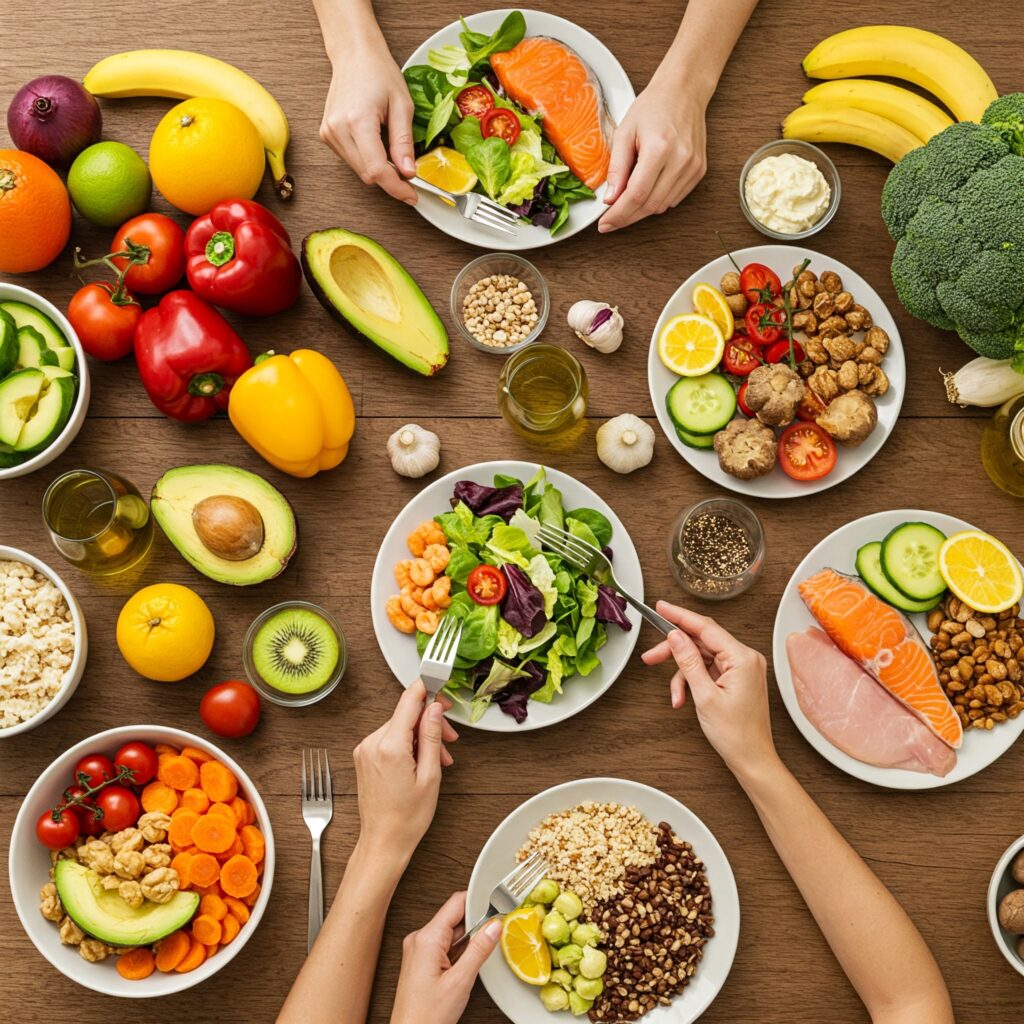QnA on Nutrition and Digestion in Animals
- Question: What is the process of taking in food called?
Answer: Ingestion
Reasoning: Ingestion is the process of taking in food through the mouth.
- Question: The process of breaking down complex food substances into simpler forms is known as:
Answer: Digestion
Reasoning: Digestion involves the breakdown of complex food substances into simpler, absorbable forms.
- Question: After digestion, the simple food substances are absorbed into the blood. This process is called:
Answer: Absorption
Reasoning: Absorption is the process where nutrients from digested food are absorbed into the bloodstream.
- Question: The absorbed food substances are utilized for energy, growth, and repair by different parts of the body. This process is called:
Answer: Assimilation
Reasoning: Assimilation is the process where absorbed nutrients are used by body cells for various functions.
- Question: The process by which undigested food is removed from the body is called:
Answer: Egestion
Reasoning: Egestion is the removal of undigested food and waste materials from the body.
- Question: Which part of the butterfly helps it to obtain its food?
Answer: Proboscis
Reasoning: The proboscis is a long, coiled feeding tube that butterflies use to suck nectar from flowers.
- Question: Which of the following animals is classified in Group 1 based on their mode of feeding?
Answer: Human Infants
Reasoning: Human infants are classified in Group 1 as they are primarily breastfed or bottle-fed.
- Question: Which organism uses its sticky tongue to catch prey?
Answer: Frog
Reasoning: Frogs use their sticky tongues to catch insects and other small prey.
- Question: Which of the following glands is associated with the production of digestive juice called saliva?
Answer: Salivary glands
Reasoning: Salivary glands produce saliva, which contains enzymes that begin the digestion of carbohydrates in the mouth.
- Question: The alimentary canal begins at the ______ and ends at the ______:
Answer: Mouth, Anus
Reasoning: The alimentary canal starts at the mouth, where food is ingested, and ends at the anus, where waste is expelled.
- Question: Which of the following organisms uses hair-like structures called cilia to ingest food?
Answer: Paramecium
Reasoning: Paramecium, a unicellular organism, uses cilia to move food particles into its mouth opening.
- Question: How does a Hydra capture its prey?
Answer: Using its tentacles
Reasoning: Hydra uses its tentacles to capture and immobilize prey with stinging cells before ingestion.
- Question: In which part of the alimentary canal does most of the digestion and absorption occur?
Answer: Small intestine
Reasoning: The small intestine is the primary site for digestion and absorption of nutrients.
- Question: Which structure in frogs helps them to catch insects?
Answer: Sticky tongue
Reasoning: Frogs use their sticky tongues to catch insects and other small prey.
- Question: Which gland produces a digestive juice that breaks down starch into sugars?
Answer: Salivary glands
Reasoning: Salivary glands produce saliva, which contains the enzyme amylase that breaks down starch into sugars.
- Question: What experiment can be done to test the action of saliva on starch?
Answer: Put boiled potato pieces in test tube A and chewed potato pieces in test tube B, then add iodine solution to both.
Reasoning: This experiment demonstrates how saliva breaks down starch into simpler sugars, as evidenced by the change in color with iodine.
- Question: Why does the bite of chapatti taste sweet after chewing for some time?
Answer: Due to the action of saliva converting starch into sugar.
Reasoning: Saliva contains the enzyme amylase, which breaks down starch into sugar, causing a sweet taste.
- Question: Which of the following is NOT a function of the tongue?
Answer: Breaking down food into simpler substances.
Reasoning: The tongue helps in mixing food with saliva, tasting, and pushing food into the food pipe but does not break down food into simpler substances.
- Question: At what age do humans typically lose their milk teeth?
Answer: 10-12 years
Reasoning: Milk teeth are usually lost between the ages of 10 and 12, making way for permanent teeth.
- Question: Which type of teeth are used for cutting food?
Answer: Incisors
Reasoning: Incisors are the sharp, chisel-shaped front teeth used for cutting food.
- Question: How many premolars are there in each jaw?
Answer: Four
Reasoning: There are two premolars on each side of the upper and lower jaws, making a total of four premolars in each jaw.
- Question: Tooth decay can be avoided by:
Answer: Brushing teeth at least twice a day
Reasoning: Regular brushing helps remove food particles and plaque, preventing tooth decay.
- Question: What is the movement of food in the esophagus called?
Answer: Peristalsis
Reasoning: Peristalsis is the wave-like muscle contractions that move food through the esophagus.
- Question: Which gland secretes hydrochloric acid?
Answer: Gastric glands
Reasoning: The gastric glands in the stomach secrete hydrochloric acid, which aids in digestion.
- Question: What is the role of bile juice in digestion?
Answer: Breaks down fats
Reasoning: Bile juice, produced by the liver and stored in the gallbladder, helps in the emulsification and breakdown of fats.
- Question: Which part of the digestive system is the longest?
Answer: Small intestine
Reasoning: The small intestine is the longest part of the digestive system, measuring about 20 feet in length.
- Question: What is the function of villi in the small intestine?
Answer: To absorb nutrients
Reasoning: Villi are small finger-like projections that increase the surface area for absorption of nutrients in the small intestine.
- Question: Where does the absorption of water and salts primarily occur?
Answer: Large intestine
Reasoning: The large intestine is responsible for absorbing water and salts from the remaining undigested food matter.
- Question: Which of the following statements is incorrect about the human digestive system?
Answer: The liver produces insulin.
Reasoning: The pancreas, not the liver, produces insulin. The liver produces bile.
- Question: What is the role of the pancreas in digestion?
Answer: Secretes pancreatic juice
Reasoning: The pancreas secretes pancreatic juice, which contains enzymes that help in the digestion of carbohydrates, proteins, and fats.
- Question: What is the primary function of the large intestine?
Answer: Absorption of water and formation of feces
Reasoning: The large intestine absorbs water from the remaining indigestible food matter and forms solid waste (feces).
- Question: What is the function of enamel on teeth?
Answer: To protect teeth
Reasoning: Enamel is the hard, outer layer of the tooth that protects it from decay and damage.
- Question: What is the condition caused by acids formed from plaque that affects tooth enamel?
Answer: Tooth decay
Reasoning: Plaque acids erode the enamel, leading to tooth decay.
- Question: What does the process of micturition refer to?
Answer: Expulsion of urine
Reasoning: Micturition is the process of expelling urine from the urinary bladder through the urethra.
- Question: What is the primary cause of hiccups?
Answer: Rapid contraction of the diaphragm
Reasoning: Hiccups are caused by involuntary, rapid contractions of the diaphragm.
- Question: Which component in the digestive system is responsible for the absorption of glucose and amino acids?
Answer: Small intestine
Reasoning: The small intestine absorbs glucose and amino acids through its lining into the bloodstream.
- Question: What is the process called where ruminants chew their cud a second time?
Answer: Ruminating
Reasoning: Ruminating is the process where ruminants regurgitate and chew their cud again to aid digestion.
- Question: Which of the following is NOT a part of the compound stomach in ruminants?
Answer: Caecum
Reasoning: The compound stomach of ruminants includes the rumen, reticulum, omasum, and abomasum, but not the caecum.
- Question: What is the role of bacteria in the rumen of ruminants?
Answer: Digesting cellulose
Reasoning: Bacteria in the rumen help in breaking down cellulose from plant material.
- Question: Which structure in amoeba helps in capturing and ingestion of food?
Answer: Pseudopodia
Reasoning: Pseudopodia are extensions of the cell membrane that amoeba use to capture and ingest food.
- Question: In amoeba, the food vacuole is formed by the fusion of:
Answer: Pseudopodia
Reasoning: Pseudopodia fuse to form a food vacuole where digestion takes place.
- Question: What happens to the undigested food in amoeba?
Answer: It is expelled out of the body
Reasoning: Undigested food in amoeba is expelled out of the cell through a process called exocytosis.
- Question: What is the main function of the structure represented by X in the digestive system diagram?
Answer: Absorb water from undigested food
Reasoning: The large intestine (represented by X) absorbs water from the undigested food material.
- Question: Why do humans chew food only when they have it in their mouth, but buffaloes chew continuously?
Answer: Buffaloes chew continuously because cud, the partially digested food, returns into their mouth in small lumps.
Reasoning: Buffaloes regurgitate and re-chew their cud, which aids in further breaking down the food.
- Question: If a patient with cancer of the food pipe is unable to eat and swallow food, what is likely to happen?
Answer: Complete digestion of carbohydrates does not take place
Reasoning: If food cannot reach the stomach and intestines, the complete digestion of carbohydrates will not occur.
- Question: Which organ secretes bile juice?
Answer: Liver
Reasoning: The liver secretes bile juice, which is stored in the gallbladder and released into the small intestine.
- Question: Which type of food should be avoided by a person who had their gall bladder removed?
Answer: Fats
Reasoning: Without a gallbladder, bile is not stored and released efficiently, making it difficult to digest fats.
- Question: Which organ of the alimentary canal does digestion of food not occur?
Answer: Esophagus
Reasoning: The esophagus is a muscular tube that transports food from the mouth to the stomach, and no digestion occurs there.
- Question: What is the function of gastric juices secreted in the stomach?
Answer: Digestion of proteins
Reasoning: Gastric juices contain pepsin and hydrochloric acid, which aid in the digestion of proteins.
- Question: In which part of the digestive system does no digestion occur?
Answer: Esophagus
Reasoning: The esophagus is responsible for transporting food to the stomach, and no digestion occurs there.
- Question: What role do villi play in the small intestine?
Answer: They help in the absorption of digested food
Reasoning: Villi increase the surface area for absorption of nutrients in the small intestine.
- Question: Why is the stomach considered a muscular elastic bag?
Answer: It churns food
Reasoning: The stomach has strong muscular walls that contract and churn food to mix it with digestive juices.
- Question: What happens if digestion completes in the small intestine?
Answer: Nutrients are absorbed into the blood
Reasoning: Once digestion is complete, nutrients are absorbed through the walls of the small intestine into the bloodstream.
- Question: Which substance in the stomach is corrosive in nature but does not harm the stomach?
Answer: Hydrochloric acid
Reasoning: Hydrochloric acid aids in digestion and kills bacteria, and the stomach lining is protected by mucus.
- Question: What is the role of pancreatic juice in digestion?
Answer: All of the above
Reasoning: Pancreatic juice contains enzymes that digest fats, carbohydrates, and proteins, and also neutralizes stomach acid.
- Question: What is the function of the gall bladder in digestion?
Answer: It stores bile juice
Reasoning: The gall bladder stores bile produced by the liver and releases it into the small intestine to aid in fat digestion.



